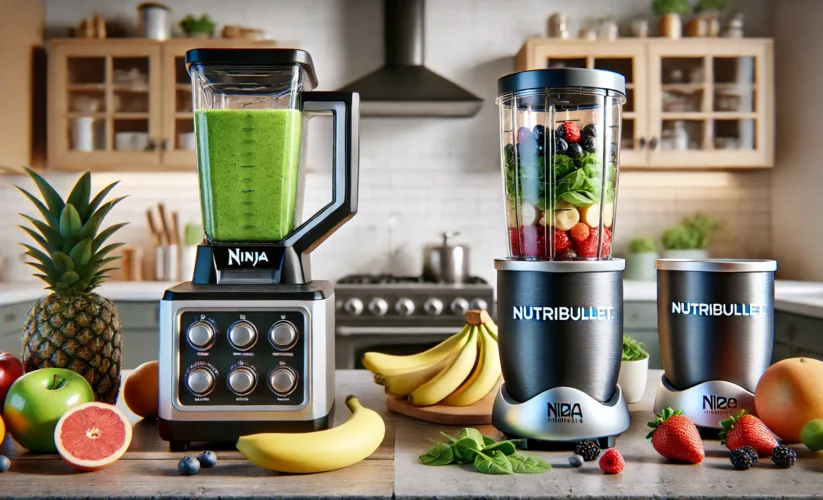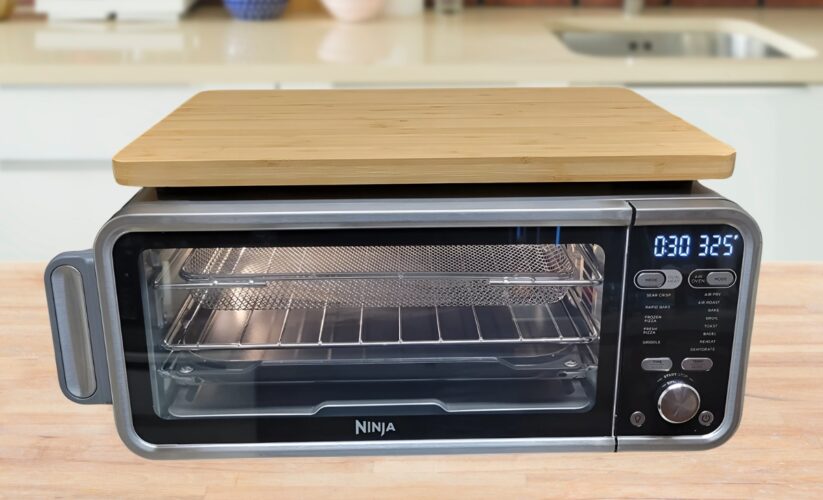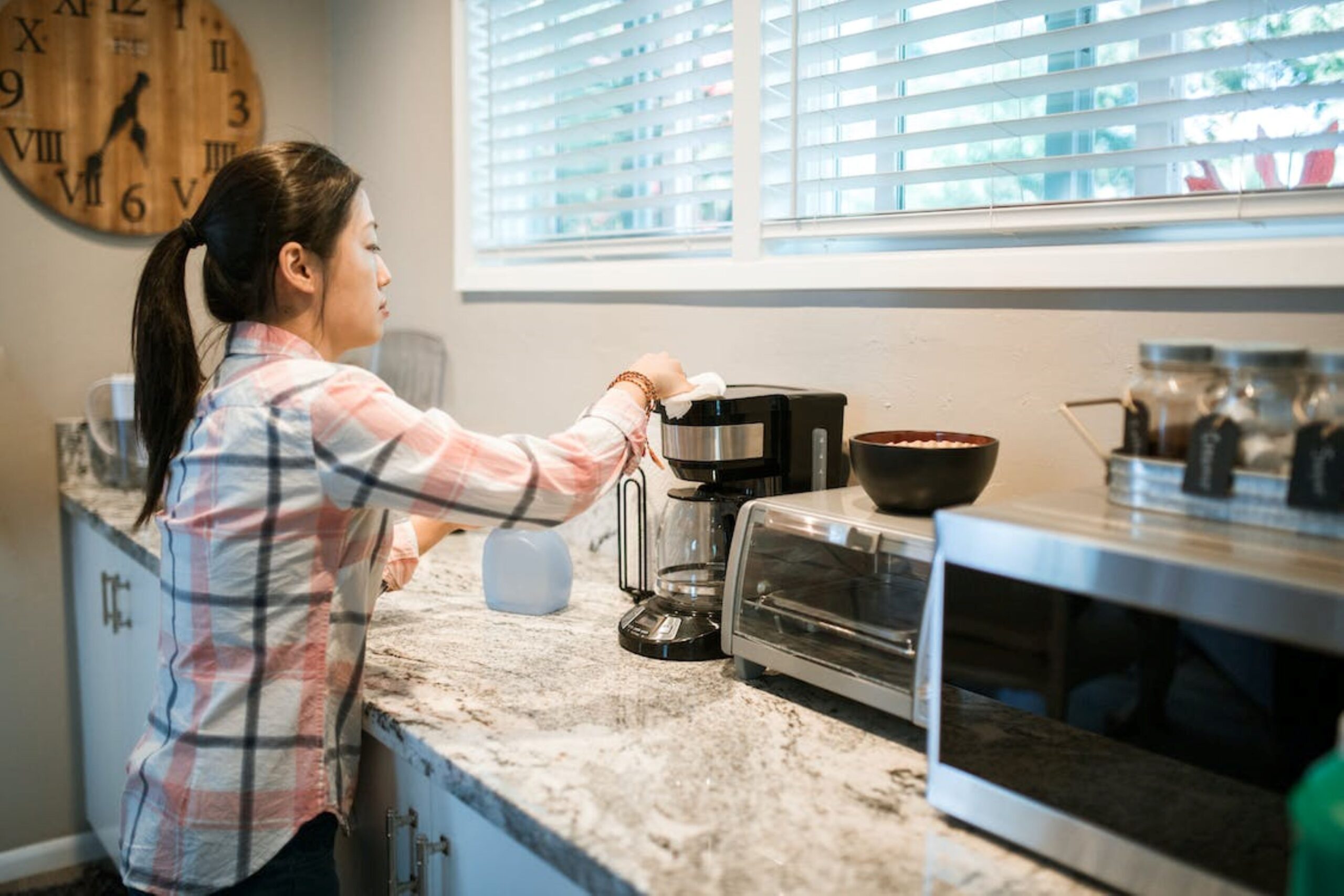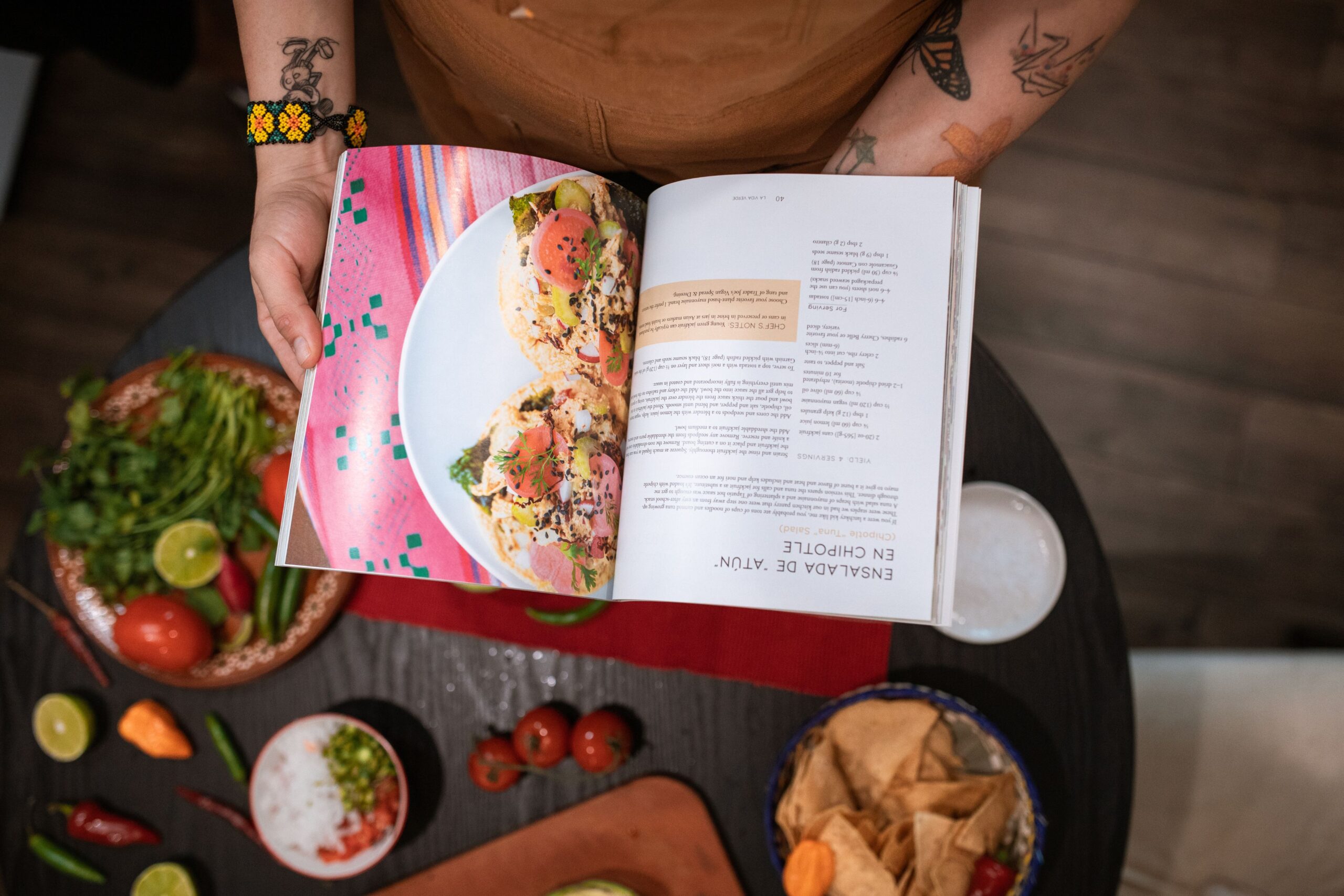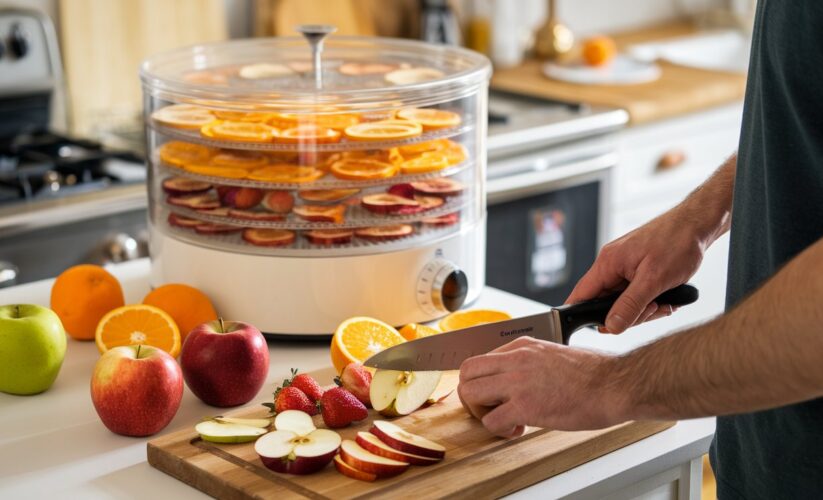
How to Dehydrate Fruit in the Ninja Foodi?
Dehydrating fruit in Ninja Foodi is a fantastic way to preserve fresh produce, create healthy snacks, and reduce food waste. If you own a Ninja Foodi, you’re in luck because this multi-purpose appliance isn’t just for pressure cooking or air frying. Its dehydrating function makes it incredibly easy to create delicious dried fruit at home! Whether you’re new to dehydrating or simply want to explore more ways to use your Ninja Foodi, this guide will walk you through the process step-by-step.
In this article, you will learn all you want to know about dehydrating fruit, the preparation process, storage, and how to make sure that the fruits retain their flavor and nutrients. Now let’s get into it!
Don’t have time to read? 🎧 Listen to our podcast instead! Click play below to enjoy the full episode on the go, and catch all the tips and insights in just a few minutes.
Key Takeaways
- What You Need: To dehydrate fruit you only need fresh fruit, the Ninja Foodi with dehydration setting and some other items which include a knife and trays.
- Step-by-Step Process: Washing, peeling and slicing the fruits is an important process so that they get dehydrated evenly.
- Dehydrating Time: The time it takes to dry the fruit varies with different fruits taking between 4 to 12 hours.
- Storage Tips: To ensure that the dehydrated fruit remains fresh over a long period of time it should be stored in an airtight container.
- Healthier Option: Dried fruit is a natural fruit snack that does not contain added preservatives and can be taken while one is on the move or used in meals such as oatmeal or salads.
Recommended Products on Amazon
To maximize your dehydrating experience, here are some must-have tools to use with your Ninja Foodi:
Ninja FD401 LP3 Foodi 12-in-1 Deluxe XL 8 qt
No products found.
| Pros | Cons |
|---|---|
| Multi-Functionality: This 12-in-1 appliance replaces multiple kitchen gadgets, saving space and reducing clutter. From pressure cooking and air frying to slow cooking and dehydrating, it covers all your cooking needs. Large Capacity: The 8-quart ceramic-coated pot and 5-quart Cook & Crisp basket are perfect for feeding large families or hosting gatherings. It even holds a 7-lb chicken with ease. TenderCrisp Technology: Pressure cooks food to lock in moisture, then finishes with a crispy, golden texture using the air fryer function. It’s perfect for achieving juicy meat with a satisfying crunch. | Heavy and Bulky: Weighing 26 pounds and with dimensions of 14.57″D x 16.1″W x 14.2″H, the appliance is quite large and can take up significant counter or storage space. Learning Curve: With 12 functions, it might take time for beginners to fully explore and master all of its capabilities. No Separate Lid for Air Frying: While the crisping lid is built-in, it cannot be removed, which can make storage a bit cumbersome. |
The Ninja FD401 Foodi Deluxe XL is a highly versatile, all-in-one kitchen appliance that combines pressure cooking, air frying, steaming, slow cooking, searing, sautéing, dehydrating, and more. With its 8-quart capacity and 12 programmable cooking functions, it’s ideal for families or anyone looking to streamline meal preparation. Below, we break down the key pros and cons of this popular appliance to help you decide if it’s the right fit for your kitchen.
Dehydrator Rack Stainless Steel Stand
- Excellent Dehydrator Rack:Dehydrator rack is 8.5 in diameter and 5 inches in height. The tray diameter of 8 in and 5 shelves,they are individually removable. Use the Dehydrator Rack with an air fryer! Enjoy tasty food with family and friends
- Little Gadget, Big Help:Dehydrator rack can dehydrate, bake, or steaming food. Handles at the top for ease of transporting. If you have an air fryer and wish to dehydrate, this rack presents a lot of money and give you most of the functionalities of a dehydrator
- Food Grade Materials:Moyios dehydrator rack is made of food-grade stainless steel 304. It’s sturdy and surety. You can confidently provide all kinds of healthy food to your family every day, or you can also use it to make pet food
| Pros | Cons |
|---|---|
| High-Quality Material: Made of durable, food-grade stainless steel for long-lasting and safe use. Space-Saving Design: The collapsible, stackable tiers make it easy to store and versatile for various tasks. Perfect Fit: Designed specifically for Ninja Foodi 6.5 & 8 Qt models and Instant Pot Air Fryer 8 Qt. | Limited Space Between Racks: Taller or thicker food items may not fit well on the shelves. Manual Rotation Needed: Trays may need to be rotated for even dehydration results. Small Batch Size: Best for smaller quantities, which might not suit larger households. |
This Moyios Dehydrator Rack is a versatile and durable accessory designed for the Ninja Foodi 6.5 & 8 Qt models, as well as the Instant Pot Duo Crisp 8 Qt. With 5 stackable, removable shelves made of food-grade stainless steel, it’s perfect for dehydrating, baking, or steaming. Its collapsible design makes it easy to store while maximizing functionality in your kitchen.
Safe Mandoline Slicer 5 in 1 Chopper
- SAFER SLICER: Safety mandolin slicer for any cook. Sharp hidden blade Slicing is fast, uniform, and easy to set up and clean up, and does not need to glove up or change the blade to use it, This is definitely an upgrade replacement your cooking daily.
- VERSATILE: ONCE FOR ALL’s vegetable slicer offers 4 mode choices julienne, matchstick, slicing, and dicing at once no need to change the blade. Adjustable thickness 0.1-8mm great for quickly slicing potatoes, carrots, cucumbers, onions…
- HIGH QUALITY: The food mandolin is made of 420 stainless steel blades, safe, and healthy, vegetable slicer is a good idea for the festival of wedding or home gift.
| Pros | Cons |
|---|---|
| Safe and Hands-Free: Hidden blades and a safety lock ensure cutting without risking injury—no gloves or direct contact with the blades needed. Adjustable Thickness: Offers precise cutting options from 0.1 to 8 mm for slicing, dicing, and julienning. Easy to Clean and Store: Collapsible design and included cleaning brush make cleanup simple, and it takes up minimal space. | Plastic Build: Some users may find the plastic body less durable for heavy-duty use over time. Learning Curve: Adjusting settings and getting consistent cuts may take some practice initially. Not Ideal for Large Batches: Best suited for small to medium amounts of food prep rather than bulk slicing. |
The ONCE FOR ALL Safe Mandoline Slicer is a versatile kitchen tool designed for safe, efficient, and fast meal prep. With its hidden stainless steel blades and adjustable thickness settings ranging from 0.1–8 mm, it slices, dices, juliennes, and chops vegetables and fruits with ease. Its safety-focused design eliminates the need for gloves, ensuring hands stay protected while cutting. Compact and easy to clean, it’s a great addition to any kitchen for quick and hassle-free food prep.
Silicone Dehydrator Sheets
- 🍎Safety- BPA Free: Silicone dehydrator sheets made from premium non stick heat-resistant(-40℃ to 220℃ / -40℉ to 428℉) food grade silicone,non-stick and reusable.
- 🍎Versatile application for dehydrator sheets fit for excalibur 2500, 3500, 2900 or 3900 non stick food and steaming mesh for dumpling chinese bun bread and pastry food dim sum mesh.
- 🍎Easy To Clean: They help keep our dehydrated food from sticking to the shelves. The dehydrator tray liner can be washed at the sink and dishwasher with just regular dish soap and warm water water.So much easier than having to wash the dehydrator shelves.
| Pros | Cons |
|---|---|
| Non-Stick and Food-Safe: Made of BPA-free, food-grade silicone that’s heat-resistant and reusable. Customizable Fit: Sheets can be cut to fit any dehydrator tray, making them versatile for different models. Easy to Clean: Dishwasher-safe and simple to wash by hand with soap and water. | Thin Design: Sheets are 0.8mm thick, which may feel flimsy when handling heavier foods. Mesh Holes: The fine mesh design can limit airflow for very dense or sticky foods like thick purees. Only White Color: Limited color options may show stains over time, especially with darker foods. |
The DOSTK Silicone Dehydrator Sheets are reusable, non-stick tray liners made from food-grade BPA-free silicone. Designed to fit a variety of dehydrators, these 14 x 14-inch sheets can be cut to size for a perfect fit. With a fine mesh design, they allow for excellent airflow, ensuring even drying while preventing food from sticking. Easy to clean and heat-resistant up to 428°F, these sheets are ideal for drying fruits, vegetables, herbs, and more.
6-pack 16oz Glass jars with Airtight Lids
- High-Grade Glass: Made with premium BPA-free and lead-free food-grade glass, ensures long-lasting durability and offers a clear view of contents, preserving the freshness and integrity of stored food.
- Unbeatable Airtight Sealing: The specially designed lid ensures an airtight seal, keeping contents fresh for longer and preventing any leaks. Whether you’re on the move or packing a lunch, it provides a hassle-free transport experience.
- Stackable Design: The unique recessed top allows for easy stacking, optimizing storage space without risking stability. The edge guard on the lid adds an extra layer of safety.
| Pros | Cons |
|---|---|
| High-Quality Material: Made from BPA-free, food-grade glass for durability and safety, with a clear view of contents. Airtight Seal: The specially designed lids ensure a leak-proof, airtight seal to keep food fresh and prevent spills. Multi-Purpose: Perfect for storing oats, yogurt, jams, sauces, snacks, and even DIY crafts. | Heavy Weight: Being made of glass, the jars are heavier compared to plastic alternatives, which may not be ideal for on-the-go use. White Lid Shows Stains: The white lids can stain over time, especially when storing colorful foods like sauces. Limited Capacity: While 16oz is perfect for small portions, it may not accommodate larger food storage needs. |
The NETANY 6-Pack 16oz Glass Jars are versatile, high-quality storage containers made from premium BPA-free, lead-free food-grade glass. Designed with airtight lids and a wide-mouth opening, they’re perfect for storing overnight oats, yogurt, snacks, spices, sugar, and even homemade jams or sauces. With a stackable design for space-saving storage, these jars combine functionality and durability, making them an essential addition to any kitchen.
Why Dehydrate Fruit at Home?
Dehydrating fruit at home offers many benefits over buying pre-packaged options. Store-bought dried fruits often contain added sugars, sulfites, or other preservatives that may not align with a healthy lifestyle. When you dehydrate fruit in the Ninja Foodi, you control the ingredients, ensuring your dried fruit is natural, nutrient-rich, and free of additives.
Benefits of Dehydrating at Home
- Cost Savings: Dehydrating fruit at home is significantly cheaper than buying pre-dried fruit.
- Reduced Food Waste: Preserve overripe or surplus fruit that might otherwise go to waste.
- Customizable Flavors: Create unique blends or add seasonings like cinnamon or ginger.
- Convenience: Homemade dried fruit is perfect for snacking, baking, or adding to cereal and salads.
Plus, when using the Ninja Foodi, you can dehydrate without investing in a separate dehydrator, making it a space-saving and efficient solution.
Step-by-Step Guide to Dehydrating Fruit in the Ninja Foodi
Step 1: Choose Your Fruit
The first step to successfully learning how to dehydrate fruit in the Ninja Foodi is selecting the right fruit. Almost any fruit can be dehydrated, but here are some popular options:
- Apples: A classic choice; they dry well into chewy, sweet slices.
- Bananas: Great for making healthy chips.
- Strawberries: Turn into tart, bite-sized snacks.
- Mangoes: Sweet, chewy, and perfect for tropical flavors.
- Pineapples: Make tangy, candy-like treats.
- Peaches: A juicy fruit that dehydrates into a soft, sweet snack.
Pro Tip: Choose ripe but firm fruits for the best results. Overripe fruit can become mushy and uneven when dehydrated.
Step 2: Prepare the Fruit
Preparation is key to ensuring even dehydration and great flavor. Follow these simple steps:
- Wash: Rinse fruits thoroughly under cold water to remove dirt and pesticides.
- Peel (if necessary): Peel fruits like bananas, mangoes, and peaches for better texture.
- Slice: Use a sharp knife or mandoline slicer to cut the fruit into uniform pieces, about 1/4-inch thick. Uniform slices ensure that all pieces dehydrate evenly.
- Optional Pre-Treatment: To prevent browning, soak fruits like apples or bananas in a solution of water and lemon juice (1 tablespoon of lemon juice per cup of water) for 5–10 minutes.
Pro Tip: Thinner slices dry faster, while thicker slices retain more chewiness.
Step 3: Arrange on Dehydrator Racks
Place the prepared fruit slices on the Ninja Foodi dehydrator racks. Be sure to:
- Arrange the slices in a single layer, avoiding any overlap.
- For sticky fruits, use silicone mats or line the racks with parchment paper.
- Leave enough space between slices for proper airflow.
Step 4: Set Up the Ninja Foodi
- Close the crisping lid.
- Select the Dehydrate function from the control panel.
- Adjust the temperature to 135°F (57°C), the ideal setting for most fruits.
- Set the time based on the fruit type and thickness of the slices:
| Fruit | Time Required |
|---|---|
| Apples | 6–8 hours |
| Bananas | 6–8 hours |
| Strawberries | 4–6 hours |
| Mangoes | 8–12 hours |
| Peaches | 6–10 hours |
Pro Tip: Always start with the lower end of the recommended time and check the progress to avoid over-drying.
Step 5: Monitor the Process
Once the dehydration cycle begins, the Ninja Foodi will handle most of the work for you. However, it’s a good idea to check on the fruit periodically, especially in the final hour. If you notice some pieces drying faster than others, remove them to prevent over-drying.
How to Test for Doneness:
- Dehydrated fruit should feel leathery and pliable, but not sticky or wet.
- For apples and bananas, a slight bend without breaking is a good indicator.
Step 6: Cool and Store
Allow the dehydrated fruit to cool completely before storing it. This step is crucial to prevent condensation, which can lead to spoilage.
Storage Tips:
- Use airtight containers, mason jars, or vacuum-sealed bags for long-term storage.
- Store the containers in a cool, dark place, away from direct sunlight.
- Properly stored, dried fruit can last up to 6 months to 1 year.
Pro Tip: For longer shelf life, add a silica gel packet to your storage container to absorb any residual moisture.
Tips for Perfect Dehydrated Fruit
- Uniform Slices: Always cut your fruit to a consistent thickness to ensure even drying.
- Rotate Trays: Halfway through the dehydration process, rotate the racks for more uniform results.
- Experiment with Flavors: Sprinkle cinnamon on apples, chili powder on mangoes, or vanilla on peaches for a gourmet twist.
- Hydrate if Needed: If your fruit becomes too dry, lightly mist it with water before eating.
- Don’t Overload: Avoid overcrowding the racks, as this can hinder proper airflow.
Troubleshooting Common Issues
Even with the right preparation and equipment, you may encounter some minor issues while dehydrating fruit in your Ninja Foodi. Below are common problems and practical solutions to help you achieve perfect results every time.
Problem: Fruit feels sticky after the recommended drying time.
- Solution: Sticky fruit indicates that it still contains moisture, which can lead to spoilage if stored prematurely. To fix this, continue dehydrating the fruit in 30-minute increments until it becomes leathery and pliable. Be sure to check it periodically to prevent over-drying.
Problem: Fruit is too crunchy or brittle.
- Solution: Overly crunchy or brittle fruit is often the result of over-drying or slicing the fruit too thin. Next time, try cutting slightly thicker slices to retain some natural chewiness. Additionally, reduce the drying time and check the fruit more frequently as it nears completion to avoid drying it out too much.
Problem: Fruit spoils during storage.
- Solution: Spoilage happens when moisture is trapped in the fruit or container during storage. To prevent this:
- Ensure the fruit is completely cooled before storing. Warm fruit can cause condensation, leading to mold.
- Store the fruit in airtight containers such as glass jars, vacuum-sealed bags, or BPA-free plastic containers.
- Keep containers in a cool, dry place with minimal exposure to humidity or light. For long-term storage, consider adding food-safe silica gel packets to absorb any lingering moisture.
Addressing these common issues will help you confidently dehydrate fruit in the Ninja Foodi, ensuring consistent, high-quality results every time. With a bit of practice and attention to detail, you’ll soon be creating perfectly dried fruit that’s flavorful, long-lasting, and ideal for healthy snacking or meal prep.
Conclusion
Dehydrating fruit in the Ninja Foodi is a game-changer for anyone who wants to make healthy snacks at home. It’s a simple and satisfying method of preserving fresh produce, reducing food waste, and enjoying sweet treats that are sugar-free and preservative-free.
All you need to do is wash, slice, and arrange the fruit. With a little bit of preparation, you can transform fresh produce into chewy, flavorful snacks in no time. The Ninja Foodi makes the process effortless, letting you easily dehydrate fruit in the Ninja Foodi to enjoy a variety of dried options. Whether it’s the sweet, tropical flavor of dried mango, the tangy taste of dehydrated strawberries, or the classic crunch of banana chips, the possibilities are endless.
You can also get creative by adding spices or flavorings to enhance each batch, such as a sprinkle of cinnamon on apples or a dash of chili powder on mango slices. These homemade dried fruits are incredibly versatile, not only are they a great snack, but they also make thoughtful homemade gifts, toppings for breakfast bowls, additions to trail mix, or ingredients for baked goods.
The best part? When stored properly in airtight containers, dehydrated fruits can last for months, making them ideal for busy households, adventurers, or anyone preparing food ahead of time.
With this guide, you have everything you need to get started. So grab your Ninja Foodi, stock up on your favorite fruits, and give it a try. Once you discover how easy and rewarding it is to dehydrate fruit in the Ninja Foodi, you’ll never want to buy store-bought dried fruit again. Not only will you enjoy healthier, homemade snacks, but you’ll also take pride in creating something delicious and nutritious from scratch.
FAQs
1. How long does it take to dehydrate fruit in the Ninja Foodi?
The time it takes to dehydrate fruit in the Ninja Foodi largely depends on the type of fruit, its moisture content, and the thickness of the slices. For example:
- Apples and bananas: These typically take 6–8 hours when sliced to about 1/4-inch thick.
- Strawberries: Since they have a lower moisture content and are often cut thin, they can be ready in 4–6 hours.
- Mangoes and pineapples: Due to their high water content, they may take 8–12 hours or longer to fully dehydrate.
It’s always a good idea to start with the recommended time and check for doneness towards the end. Factors like humidity in your home or the thickness of the fruit can slightly affect the drying time.
2. Can I dehydrate frozen fruit in the Ninja Foodi?
Yes, you can dehydrate frozen fruit in the Ninja Foodi, but there are a few steps you need to follow first.
- Thaw the frozen fruit: Allow it to fully thaw at room temperature or in the refrigerator. This will remove the icy texture and make it easier to handle.
- Pat it dry: Use a clean paper towel or cloth to gently dab away any excess moisture. Too much water can prolong the dehydration time.
- Slice as needed: If the fruit pieces are too large, cut them into even slices to ensure consistent drying.
Frozen fruit can sometimes be softer or mushier after thawing, so handle it carefully. Once prepped, simply follow the same dehydration steps as you would for fresh fruit.
3. How do I know when the fruit is fully dehydrated?
Knowing when your fruit is perfectly dehydrated is essential to avoid under-drying or over-drying. Here’s what to look for:
- Texture: Dehydrated fruit should feel leathery and pliable when you touch it. It should not feel sticky or wet, as that indicates there’s still moisture left.
- Test for doneness: Let the piece cool to room temperature, then try to bend it. If it bends easily without breaking or cracking, it’s done.
- Appearance: The fruit will shrink in size and darken slightly in color, but it should not look burned or brittle.
If some pieces feel wetter or thicker than others, remove the fully dried fruit and allow the remaining pieces to continue dehydrating for an additional 30–60 minutes.
4. Is dehydrated fruit healthy?
Yes, dehydrated fruit is a healthy snack option because it retains most of the vitamins, minerals, and fiber found in fresh fruit. However, since the dehydration process removes the water content, the natural sugars in the fruit become more concentrated. This means:
- Higher calorie density: Dehydrated fruit contains more calories per serving compared to fresh fruit, so portion control is key.
- No additives: When you dehydrate fruit at home, you can ensure there are no added sugars, artificial flavors, or preservatives, making it a much healthier choice than many store-bought options.
Dehydrated fruit is a great snack for energy on the go, adding to trail mixes, or incorporating into oatmeal or baked goods. Just remember to enjoy it in moderation as part of a balanced diet.
5. How should I store dehydrated fruit?
Proper storage is essential to maintain the quality and shelf life of dehydrated fruit. Here’s how to store it correctly:
- Use airtight containers: Mason jars, vacuum-sealed bags, or BPA-free plastic containers work well to prevent air and moisture from getting in.
- Cool, dry location: Store the containers in a cool, dry place away from direct sunlight, heat, or humidity, as these factors can cause spoilage.
- Avoid moisture: Any excess moisture can cause mold growth. If you’re unsure, add a small silica gel packet (food-safe) to absorb any lingering moisture.
- Label and date: Always mark the container with the type of fruit and the date it was dehydrated so you can keep track of its freshness.
When stored properly, dehydrated fruit can last anywhere from 6 months to 1 year. For longer storage, you can freeze the fruit in vacuum-sealed bags to further extend its shelf life. Always check for signs of spoilage, like mold or an off smell, before consuming.
Last update on 2025-12-22 / Affiliate links / Images from Amazon Product Advertising API
*We may earn a commission for purchases made using our links. Please see our disclosure to learn more.





